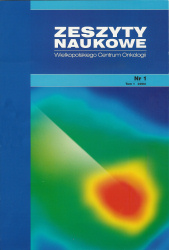Abstract
Rak przełyku stanowi około 2% wszystkich nowotworów złośliwych. Zastosowanie leczenia u pacjenta z rakiem przełyku zależy od dokładnej lokalizacji nowotworu i jego stadium. Pacjenci ze zmianami naciekającymi naczynia krwionośne, serce, płuca i węzły chłonne kwalifikują się do radykalnej chemioradioterapii. Celem tego badania było przejrzenie technik napromieniowania w przypadku raka przełyku. W tym artykule przedstawiono techniki konwencjonalnej radioterapii 2D i 3D konformalnej radioterapii (3DCRT). Systemy komputerowe do planowania leczenia wpłynęły na rozwój dynamicznych technik, umożliwiając nowocześniejszą radioterapię z modulacją intensywności (IMRT) i terapię łukiem wolumetrycznym (VMAT) lub stosowanie terapii protonowej.
References
https://onkologia.org.pl/pl/nowotwor-przelyku-czynniki-ryzyka#page-main-image [dostęp 23.03.2024]
Potemski P. Jassem J., Krzakowski M., Nowotwory układu pokarmowego, Gdańsk,Via Medica, 2014, s.100-103
Kowlczyk M., Piątek M. Imielska- Zdunek D., Oesophageal cancer — case report and literature review, Oncol Clin Pract 2017; 13: 30–33.
Zhang, B., Mo, Z., Du, W., et al .Intensity-modulated radiation therapy versus 2D-RT or 3D-CRT for the treatment of nasopharyngeal carcinoma: a systematic review and meta-analysis. Oral oncology, 51(11), 1041-1046
Duress B. T., Tigeneh W., Bogate M., Short-Course 2-Dimensional Radiation Therapy in the Palliative Treatment of Esophageal Cancer in a Developing Country: A Phase II Study, Radiation Oncology, 2019, 106(1): 67-72
Bradley J. D., Mutic S., Technical basis of radiation therapy Berlin, 2008: 511-524
Malicki J., Ślosarek K., Planowanie leczenia i dozymetria w radioterapii, via Medica, Gdańsk, 2016
Fenkell L., Kaminsky L., Green S., et al, Dosimetric comparision of IMRT vs. 3D conformal radiotherapy in the treatment of cancer of the cervical esophagus, Radiotherapy and Oncol., 2008;89(3): 287-291
Nishmura Y., Komaki R., Intensity-Modulated Radiation Therapy: Clinical Evidence and Techniques, 2015; 301-314
Benthuysen L.V., Hales L., Podgorsak M.B., Volumetric modulated arc therapy vs. IMRT for the treatment of distal esophageal cancer, Medical Dosimetry, 2011; 36(4): 404-409
Williams P.C., IMRT: delivery techniques and quality assurance, the British journal of radiology,2003: 76: 766-776
Ślosarek K., Składowski K., Rembielak A.; Modelacja intensywności wiązki w radioterapii IMRT- opis techniki, Nowotwory, 2001; 51
Bentzen S., Constine L.S., Deasy J.O., Quantitative Analyses of Normal Tissue Effects in the Clinic, Int J Radiat Oncol Biol Phys. 2010 Mar 1; 76(3 Suppl): S3–S9.
Shah Y., Chen H., Wang H., et al., Investigation of Predictors to Achieve Acceptable Lung Dose in T-Shaped Upper and Middle Esophageal Cancer With IMRT and VMAT, Front Oncol., 2021; 11
Acharya R., Mahapatra A., Verma H. K, Unveiling Therapeutic Targets for Esophageal Cancer: A Comprehensive Review, Curr. Oncol. 2023, 30(11), 9542-9568
Jethwa K.R., Haddock M. G., Tryggestad H., et al., The emerging role of proton therapy for esophagus cancer, Gastrointest Oncol 2020;11(1):144-156
Lin S. H., The Utility of Proton Beam Therapy with Concurrent Chemotherapy for the Treatment of Esophageal Cancers, Radiation and Cancers, 2011, 3,4090-410

This work is licensed under a Creative Commons Attribution-NoDerivatives 4.0 International License.
Copyright (c) 2024 Letters in Oncology Science
